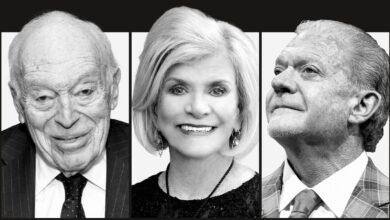What Does It Mean To Look Like A Leader?

📝 usncan Note: What Does It Mean To Look Like A Leader?
Disclaimer: This content has been prepared based on currently trending topics to increase your awareness.
The talented professionals I coach come from a variety of industries, professions, and backgrounds. They are smart, skilled, and highly competent, with positive business results that have been responsible for their career progression to this point. Most are being groomed for senior leadership positions. But many of them share a common problem: they don’t look like leaders. At least that’s how they are described to me when I’m asked to work with them.
Young businesswoman standing in front of a mirror in an office bathroom and getting focused to do presentation
getty
“Looking like a leader” (displaying leadership presence) has as many variations as there are organizations and cultures, but I’ve found that the answers to the following questions can tell me a lot about why someone does – or does not – look like a leader. How would you answer them?
Are you balanced?
The Stereotype Content Model states that we constantly evaluate one another along two dimensions: warmth and competence. When I apply this model to leadership presence, I start with the corresponding sets of nonverbal signals. One set of these signals conveys power and confidence, and the other (called “pro-social” body language) displays warmth and inclusion.
Warm body language starts by keeping your body relaxed and open. Eye contact also matters. And, of course, a smile is a sign of welcome. It says, “I’m friendly and approachable.” Tilting your head to one side is a warm, pro-social signal that you are listening and curious, and in situations where you want people to expand on what they are saying, head nods in groups of three encourages them to keep talking. Open palm gestures (an ancient way of showing that you had no weapons) still signal that you are “friend,” not “foe.” And, of course, a genuine smile is a sign of positive acknowledgement and welcome.
Confidence, power, and authority (by which people evaluate your competence) are non-verbally communicated using height and space. The taller you appear and the more room you take up, the more you appear to be in command. When you want to project confidence, stand tall and move around to claim your territory. If sitting, uncross your legs and place your feet firmly on the floor. Bring your elbows away from your body and widen your arm position. Your expanded body language will not only change the way people perceive you – it will influence the way you feel about yourself, making you feel more grounded and self-assured.
A confident businessman gesturing while giving a presentation at a press conference
getty
For leaders to be optimally influential, they need be seen as “balanced” by displaying both sets on signals. Too much warmth and you risk being labeled “nice,” but less credible. Too many power signals can make you look confident, but not caring.
Are you aligned?
Body language that is aligned with your verbal messages reinforces your leadership presence. But when what you say and how you look when you say it are out of alignment, people are forced to choose. And unconsciously they’ll discount what they hear and believe what they see. This is especially detrimental when you say something positive, and your body language shows the opposite.
From one of my clients, here’s an example: “I was in an important meeting, and the leader was telling the group how much he welcomed any input we could provide. But at the same time, he was using both his hands to non-verbally push the entire group away. The amazing thing was that he repeated this sequence several times, always saying that he would welcome our input while making the same “push away” gesture. It was all any of us could do not to laugh out loud. But we all came away with a deeper appreciation of the importance of verbal and nonverbal alignment.”
Research explains why this alignment has such an impact on an audience. Neuroscientists at Colgate University study the effects of gestures by using an electroencephalograph (EEG) machines to measure “event related potentials” – brain waves that form peaks and valleys. One of these valleys occurs when subjects are shown gestures that contradict what’s being spoken. This is the same brain wave dip that occurs when people listen to nonsensical language.
So, in a very real way, whenever you say one thing and your gestures indicate another, you simply don’t make sense. When your body language doesn’t match your words (dropping eye contact or glancing around the room while trying to convey candor, rocking back on heels when talking about the organization’s solid future, or physically pushing back when inviting people to contribute) your verbal message is lost and you don’t look like a leader.
Do you fold under pressure?
When your body caves in
getty
Because the heart, brain, and nervous system are so closely interlocked, people can often tell if you are happy or stressed by simply observing how you hold your body. If you are in a great mood, you are most likely holding your shoulders back and your head high, but if overwhelmed or depressed, your body begins to fold into itself: your shoulders begin to round forward and you cave in slightly at the chest.
But a condensed posture isn’t the only nonverbal signal of stress. I was in the audience when an executive from a financial institute was being interviewed while seated at the front of the stage, facing us. One of his staff sat across from him, reading a list of questions that had been submitted by attendees.
As this leader responded to the first inquiries, he shared his philosophy of “relationship banking” and the importance of employees to the company’s brand. While doing so, his body language was open and relaxed. His posture, facial expressions and hand gestures signaled comfort and confidence.
Then came a series of questions about executive compensation. As he answered these, his feet made their own statement. From a comfortable, loose leg cross, the executive suddenly locked his ankles tightly together, pulled them back under the chair, and began to make tiny kicks with both feet. He then re-crossed his ankles and kicked his feet again. And this behavior continued throughout the entire set of compensation questions.
If all the audience could have seen was the upper half of the executive’s body, we might have been convinced that he was still at ease, but his feet told a different story – one of anxiety and stress.
Maybe you don’t kick your feet when feeling stressed, but even a simple thing like how you breathe is also telling. Holding our breath is a primitive instinct – a hardwired reaction (the freeze portion of the “flight, fight or freeze” response) when facing a threat. Today, when threats are more likely to be psychological than physical, anxiety may still cause you to hold your breath or to breathe high in your chest is small, shallow breaths. If you notice this reaction, stop and consciously take deeper breaths, allowing your body to relax more every time you exhale.
Gestures also say a lot. Often, when people are under stress, they automatically clasp their hands in front of their lower body, creating a protective “fig leaf” effect. Whenever you use this gesture, especially during a formal presentation, it indicates that you’re insecure or uncomfortable. A better choice would be to clasp your hands at waist level.
The “fig leaf” gesture
getty
Do you sound like a leader?
Here I’m referring to how you use paralanguage: how you say what you say (vocal tone, volume, and rate of speech). As with other aspects of nonverbal communication, people make assumptions about your leadership ability based on the sound of your voice.
In some situations, this aspect of nonverbal communication becomes even more important. A study by Michael Kraus of the Yale University School of Management found that our sense of hearing may be even stronger than our sight when it comes to accurately detecting emotion. Kraus found that we are more accurate when we hear someone’s voice than when we look only at their facial expressions or see their face and hear their voice. In other words, when your communication is limited to an auditory channel — as it is on a phone call, a teleconference, or a podcast, people will be able to sense your emotional state even better.
Pitch is an influential vocal cue in social evaluation and therefore plays a key role in our choice of leaders. For example, lower-pitched speakers are more likely to be perceived as competent, experienced, and trustworthy. Research from Duke University’s Fuqua School of Business looked at the earning power of a voice as it extended to male chief executive officers. The results from 792 male Chief Executive Officers (CEOs) found that CEOs with deeper voices managed larger companies, made more money, and tended to be retained longer.
Under stress or excitement, vocal pitch tends to get higher. Women, who have naturally higher voices need to be especially aware of this. A good tip for anyone whose voice tends to rise when stressed: Before you enter the meeting room – or get on the telephone for an important call – let your voice drop into its optimal lower pitch by keeping your lips together and making the sounds “um hum, um hum, um hum.”
Go back over these questions and see what areas you might like to learn more about. Body language savvy can be your key to strengthening business relationships, presenting ideas with added impact, and looking like a leader.




